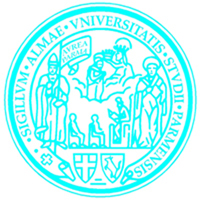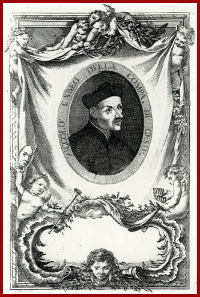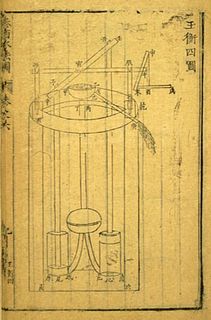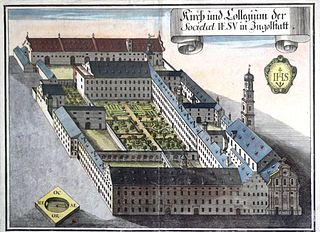Life
He was born in Rome. [1]
He was a lecturer at the Collegio Romano in the 1580s. He first taught De elementis, from 1585 to 1587, and then the three-year philosophy course from 1587 to 1590. After that he taught at Padua. [2]
His notes on the Posterior Analytics , generally Thomist, were used by Galileo. This occurred around 1588-1590, and it was through Vallius that Galileo learned the work of Jacopo Zabarella. [3] [4] It is now accepted that Vallius is the source of two logical treatises by Galileo. [5]
Vallius was plagiarized by Ludovico Carbone, in his 1597 Additamenta ad commentaria doctoris Francisci Toleti in logicam Aristotelis, which were Additions to the logic of Franciscus Toletus. [6]

The University of Parma is a public university in Parma, Emilia-Romagna, Italy. It is organised in nine departments. As of 2016 the University of Parma has about 26,000 students.

Madonna Della Strada or Santa Maria Della Strada is a painting of the Blessed Virgin Mary enshrined at the Church of the Gesù in Rome, mother church of the Society of Jesus (Jesuits) religious order of the Catholic Church; it is a variation on the basilissa (imperial) type of icon.

Paolo Frisi was an Italian mathematician and astronomer.

Niccolò Cabeo, SJ was an Italian Jesuit philosopher, theologian, engineer and mathematician.

Paolo Casati was an Italian Jesuit mathematician. Born in Piacenza to a Milanese family, he joined the Jesuits in 1634. After completing his mathematical and theological studies, he moved to Rome, where he assumed the position of professor at the Collegio Romano. He was given the chair in mathematics after teaching philosophy and theology.

The Assayer was a book published in Rome by Galileo Galilei in October 1623 and is generally considered to be one of the pioneering works of the scientific method, first broaching the idea that the book of nature is to be read with mathematical tools rather than those of scholastic philosophy, as generally held at the time.

Musurgia Universalis, sive Ars Magna Consoni et Dissoni is a 1650 work by the Jesuit scholar Athanasius Kircher. It was printed in Rome by Ludovico Grignani and dedicated to Archduke Leopold Wilhelm of Austria. It was a compendium of ancient and contemporary thinking about music, its production and its effects. It explored, in particular, the relationship between the mathematical properties of music with health and rhetoric. The work complements two of Kircher's other books: Magnes sive de Arte Magnetica had set out the secret underlying coherence of the universe and Ars Magna Lucis et Umbrae had explored the ways of knowledge and enlightenment. What Musurgia Universalis contained, through its exploration of dissonance within harmony, was an explanation of the presence of evil in the world.

Sabatino de Ursis was an Italian Jesuit who was active in 17th-century China, during the Jesuit China missions.
John Hungerford Pollen was an English Jesuit, known as a historian of the Protestant Reformation.
Martinus Smiglecius was a Polish Jesuit philosopher and logician, known for his erudite scholastic Logica.

Domenico Troili (1722–1792) was an Italian abbate and a Jesuit, who held the appointment of custodian of the library of the ruling family of Este in Modena. He is recognized as the first person who documented the fall of a meteorite, in 1766.

Gauvin Alexander Bailey is an American-Canadian author and art historian. He is Professor and Alfred and Isabel Bader Chair in Southern Baroque Art at Queen's University.
Andreas Eudaemon-Joannis (1566–1625) was a Greek Jesuit, natural philosopher and controversialist. He was sometimes known as Cydonius.

The Church of Santa María de Loreto de Achao is a Roman Catholic church located in Quinchao Island's largest town, Achao. Often referred to as «Church of Achao» —Spanish: Iglesia de Achao—, is within the Diocese of Ancud, and was built around 1740 when Chiloé Archipelago was still a part of the Spanish Crown possessions.

Achao is a town on the Chiloé Archipelago, in the south of Chile. The town is the capital of Quinchao commune on the island of the same name.

The Iglesia de Quinchao is located in the village of Quinchao, in the Chiloé Province, Los Lagos Region, Chile. It is one of the main stops on a pilgrimage path on Chiloé.
Kyōgoku Maria (京極マリア) or Yōfuku-in (養福院) was a Japanese noble lady and religious leader from the Sengoku period to the early Edo period. She was the second daughter of Azai Hisamasa as well as Azai Nagamasa's elder sister and the mother of Kyōgoku Takatsugu and Kyōgoku Takatomo. She was the mostly successful woman catechist with her own assistants as well as Naitō Julia and her women catechists. She faced the rules of samurai governments, staying true to her missionary campaigns even when Christianity was banned in Japan.

The Jesuit College of Ingolstadt was a Jesuit school in Ingolstadt, in the Duchy and Electorate of Bavaria, founded in 1556, that operated until the suppression of the Jesuit Order in 1773. The college was the headquarters of the Jesuits in Germany, and became a center of the Counter-Reformation. Many of its members taught at the University of Ingolstadt.
John William O'Malley is an American academic, Catholic historian, and Jesuit priest. He is a University Professor at Georgetown University, housed in the Department of Theology and Religious Studies. O'Malley is a widely published expert on the religious history of Early Modern Europe, with specialities on the Council of Trent, the Second Vatican Council, and the First Vatican Council.
This page is based on this
Wikipedia article Text is available under the
CC BY-SA 4.0 license; additional terms may apply.
Images, videos and audio are available under their respective licenses.













